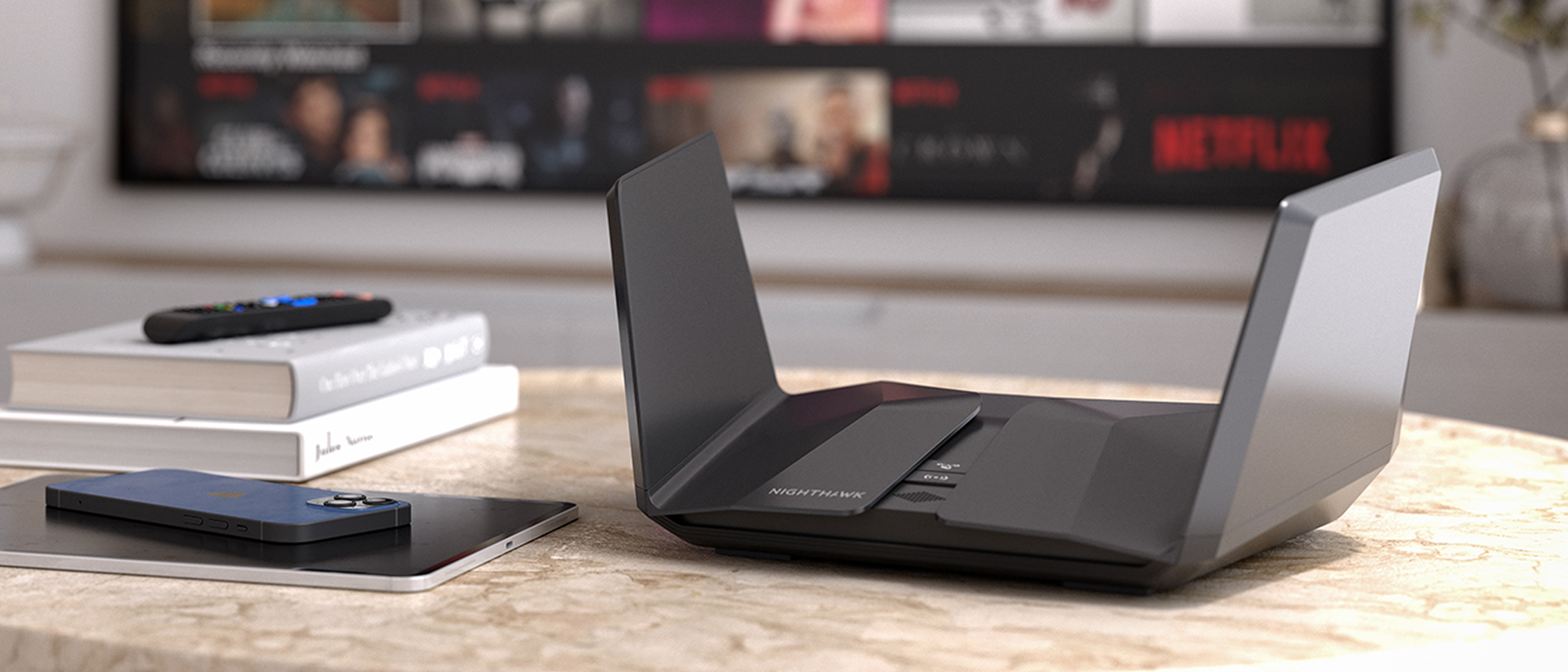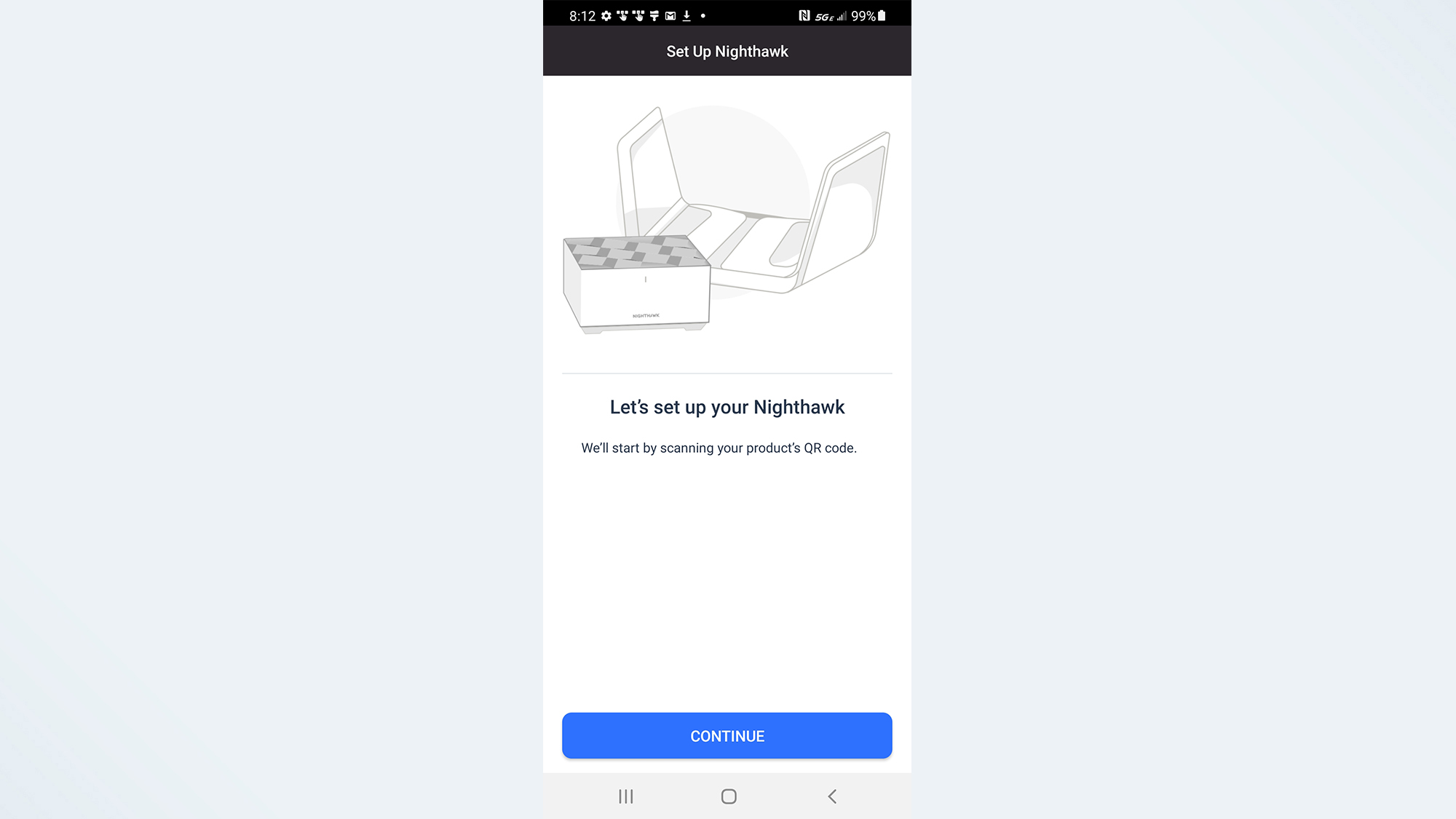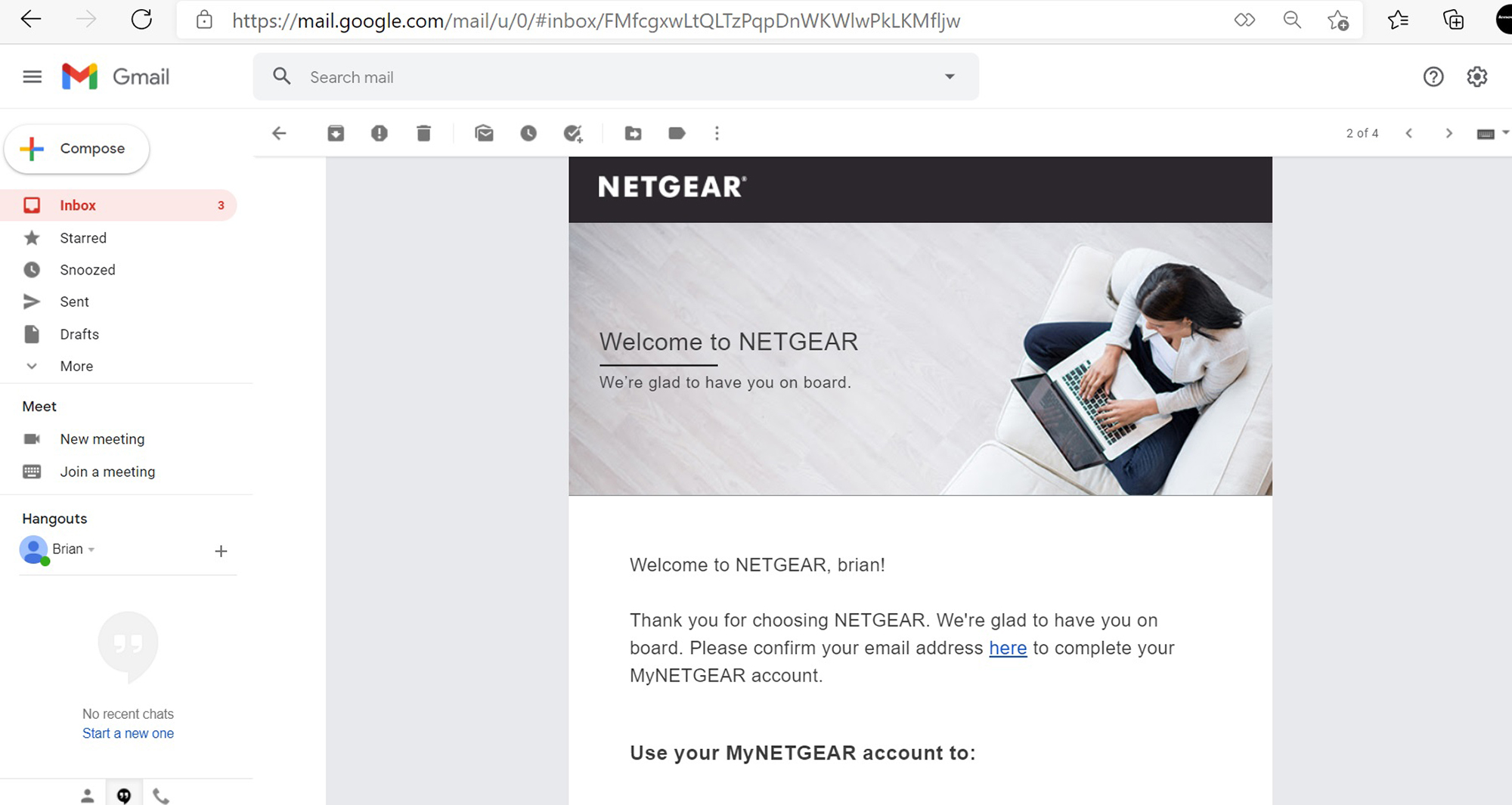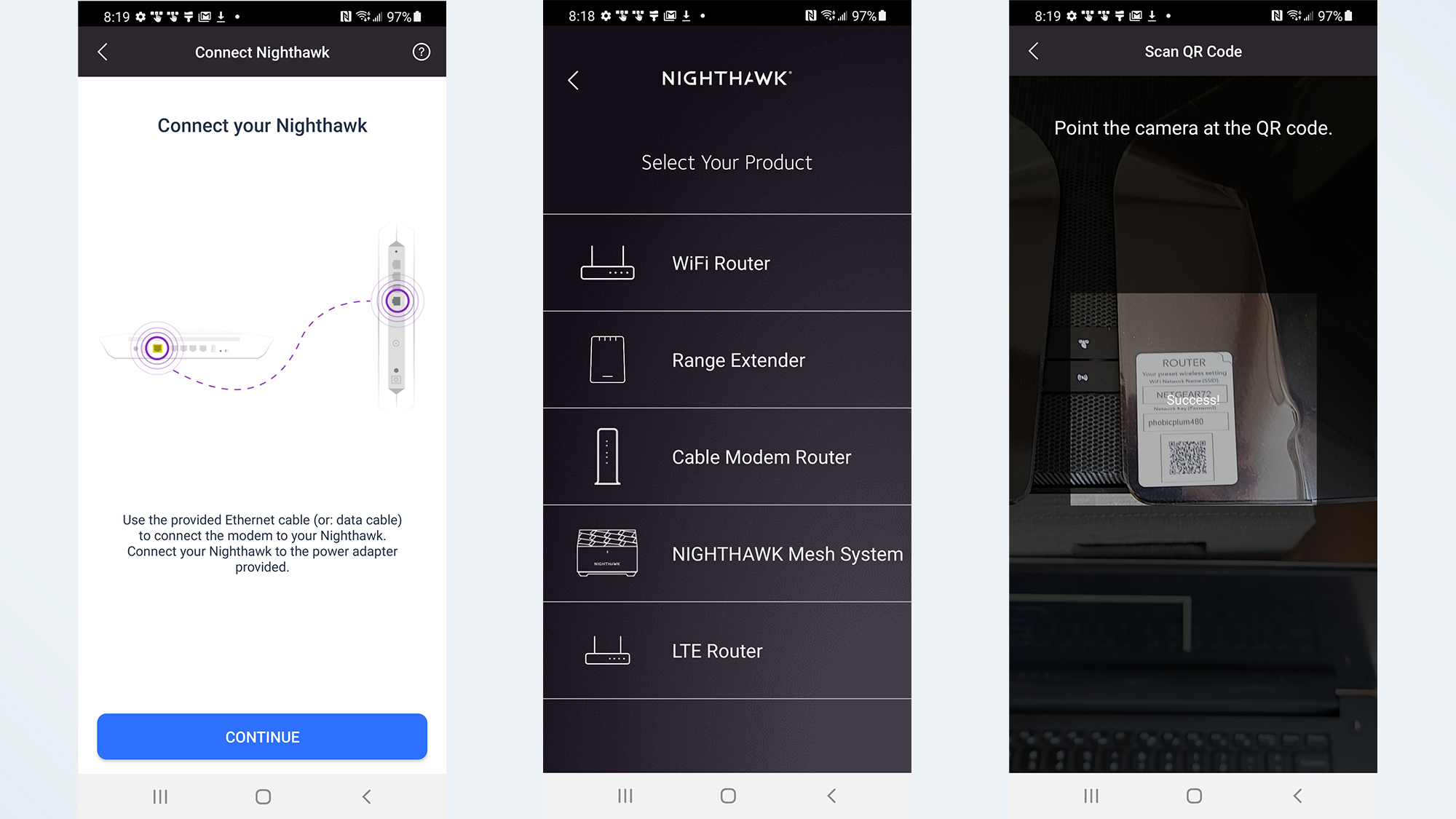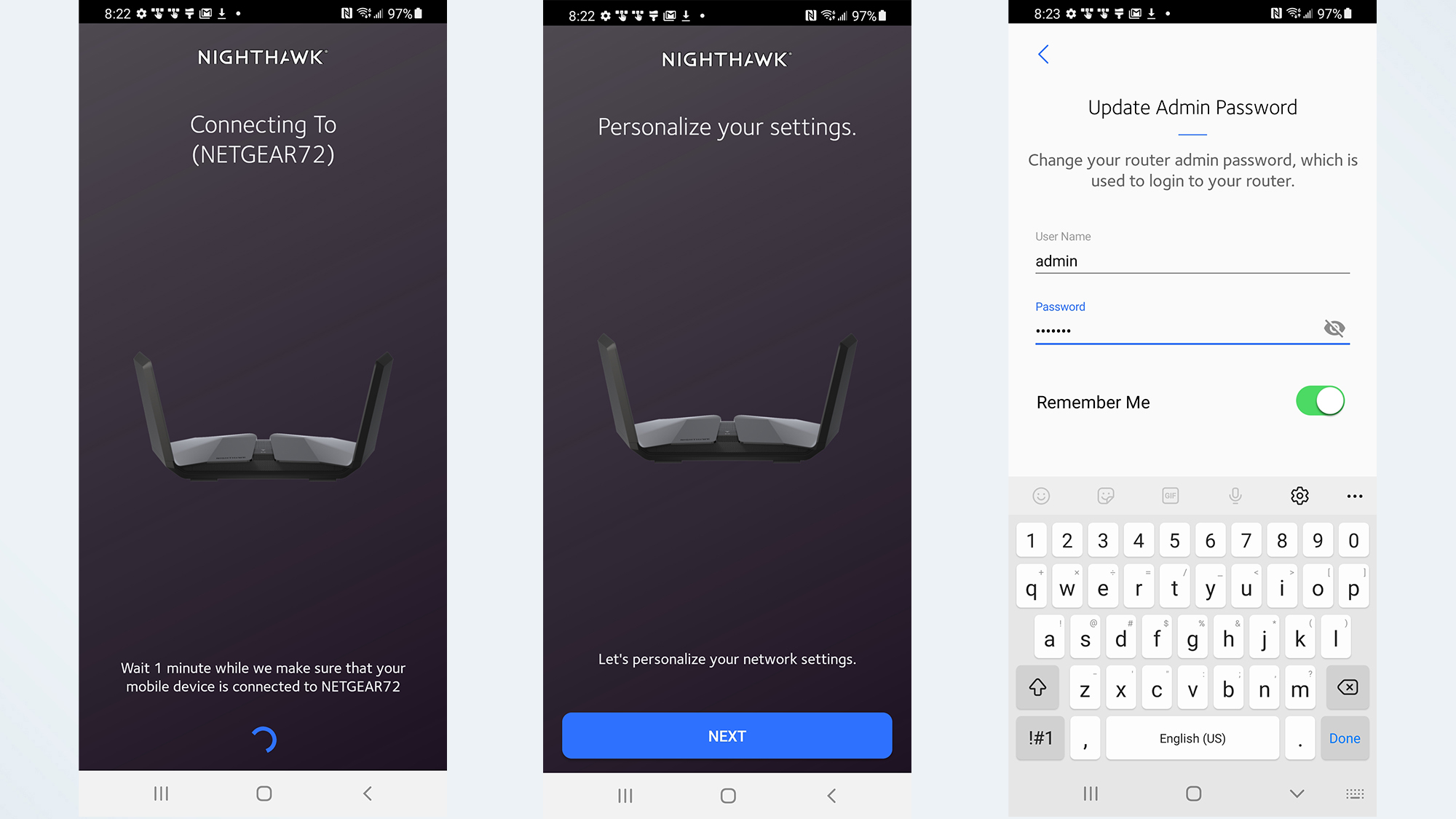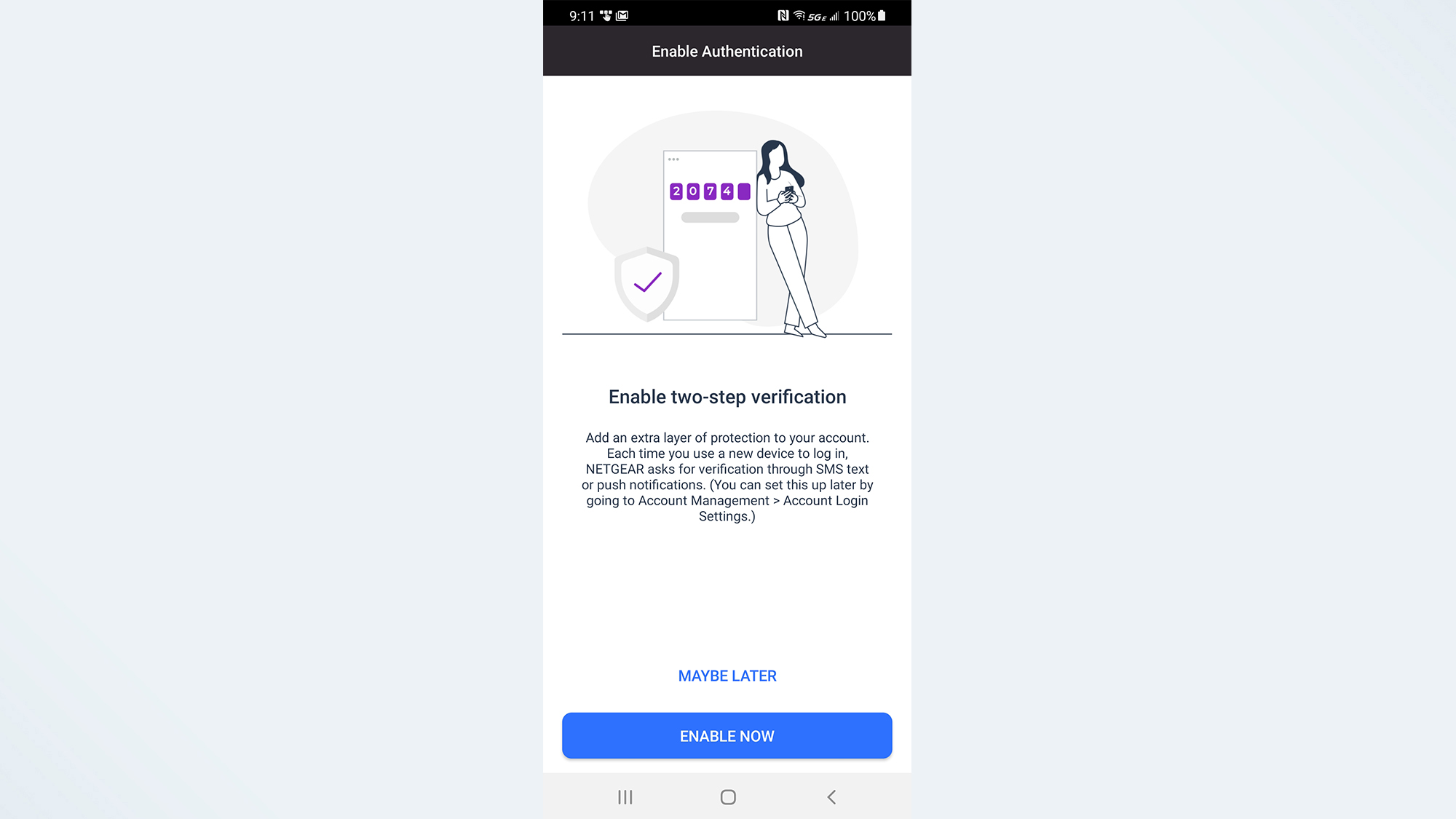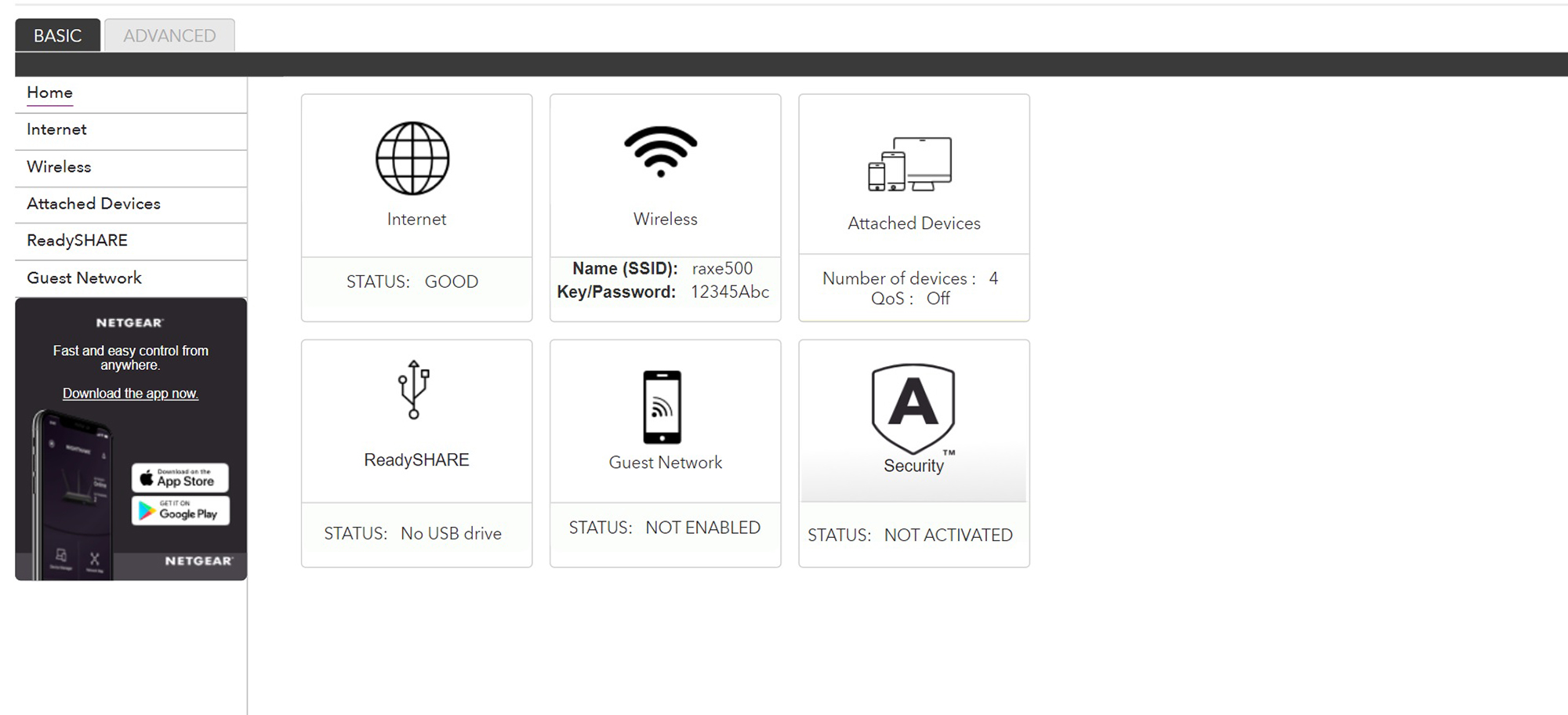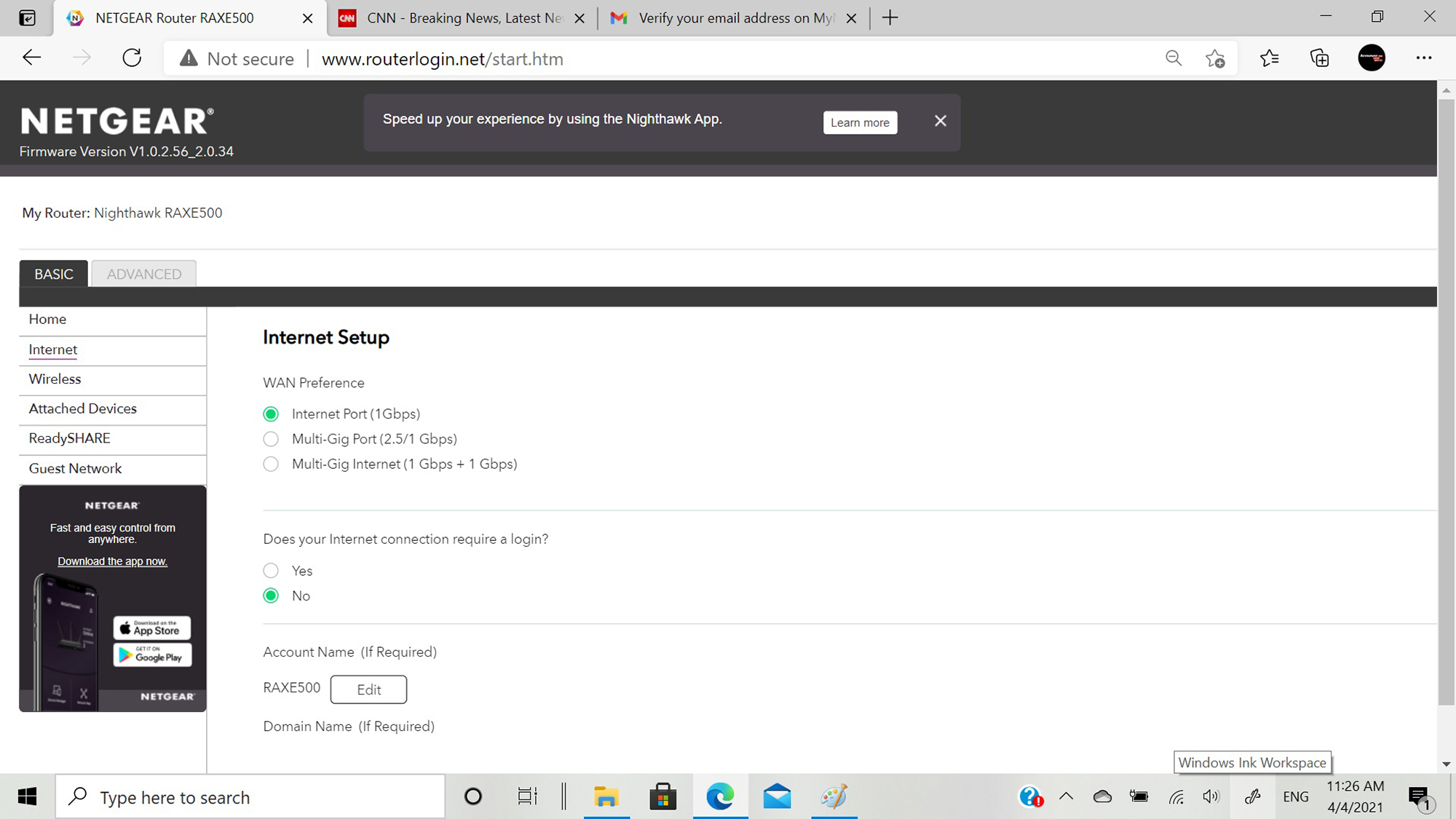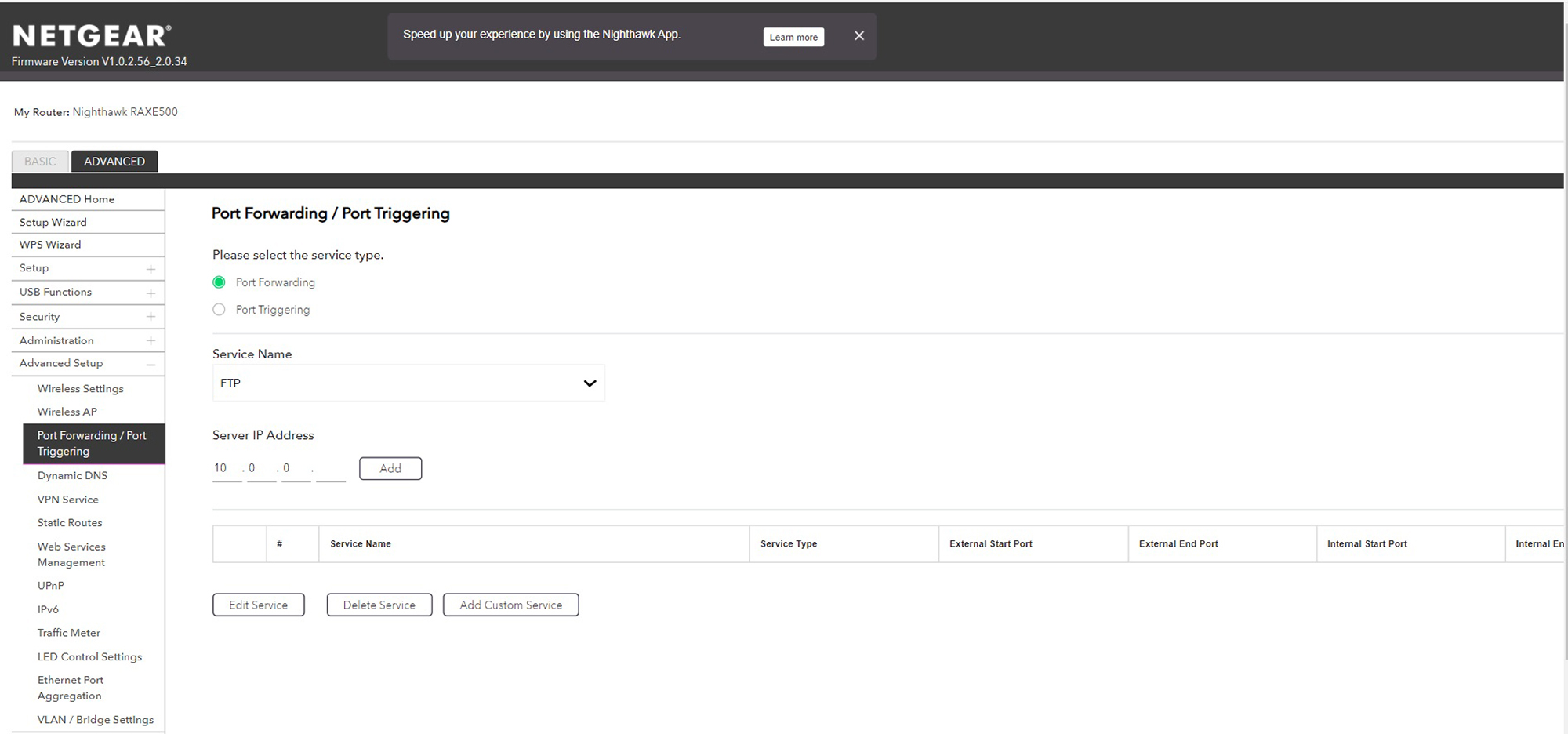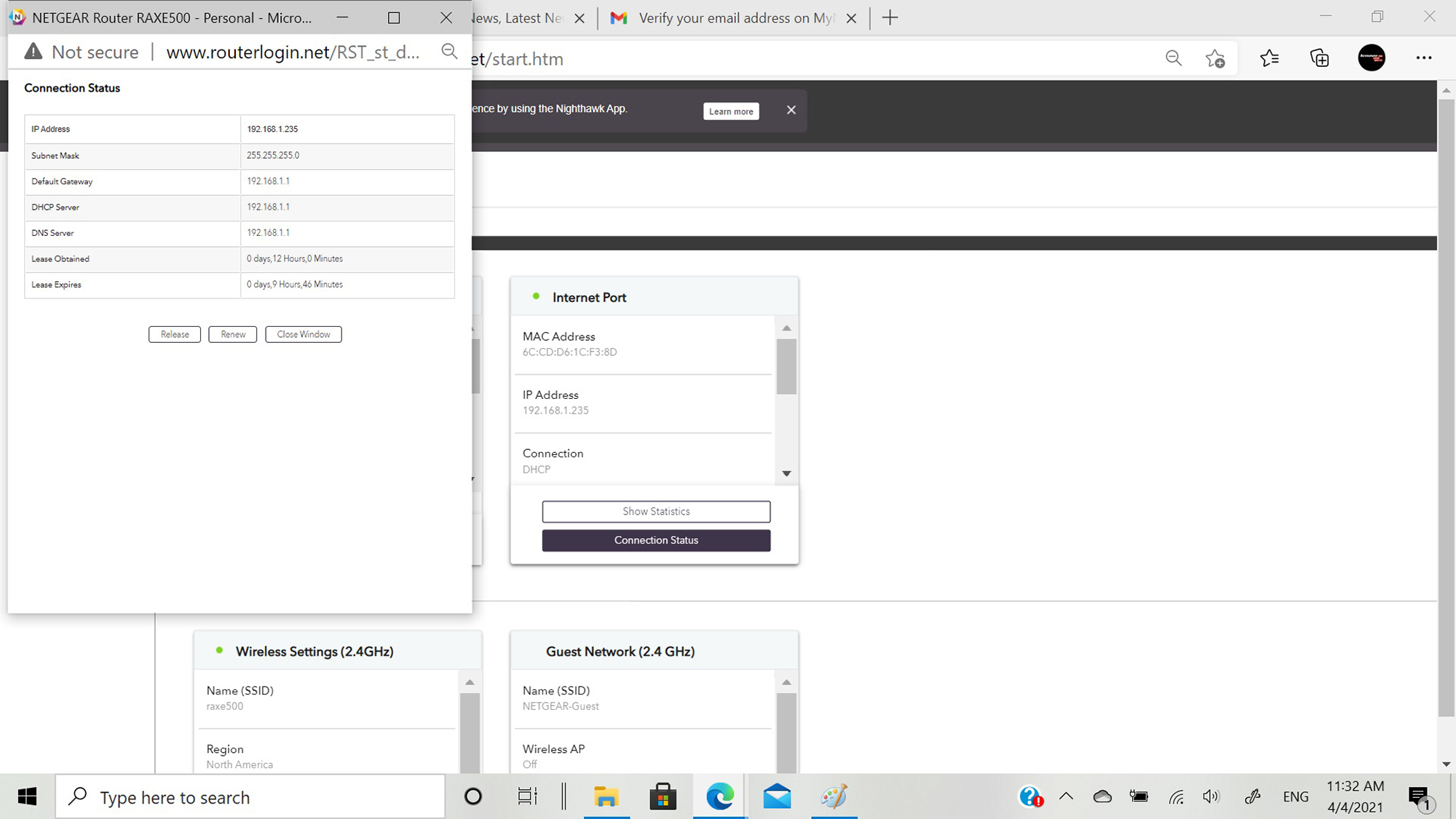Tom's Guide Verdict
By adding access to a slew of new data-delivering channels in the 6GHz spectrum, the tri-band Netgear Nighthawk RAXE500 takes the lead as the first high-performance Wi-Fi 6e router. While it’s best at close quarters and is one of the most expensive routers you can buy, the RAXE500 is worth every penny if you have the need for speed.
Pros
- +
Top speed with 6GHz band
- +
Customizability
- +
Security software
Cons
- -
Expensive
- -
Throughput declines quickly with distance
- -
90-day support policy
- -
No parental controls
Why you can trust Tom's Guide
Wi-Fi Spec: AXE11000
Number of Antennas/Removable: 8/No
Ports: 1 WAN/4 LAN gigabit per second, 2 USB 3
Processor/Memory/Storage: Quad-core 1.8GHz/1GB/512MB
Wi-Fi chip: Broadcom
Peak 802.11ac performance: 2.396Gbps (at 15 feet)
Range: 105 feet
Size: 12.0 x 8.6 x 7.3 inches
Estimated Annual Electricity Cost: $13.70
The Netgear Nighthawk RAXE500 innovates with the first Wi-Fi 6e router that moves data over the 2.4-, 5- and 6GHz frequency bands, combining the sharp looks of Netgear's current routers with the latest and greatest Wi-Fi standard. With an AXE11000 rating, the tri-band device more than lives up to the hype by delivering nearly 2.5Gbps of real-world data. It's the sort of performance that earned it the 2021 Tom's Guide Award for best Wi-Fi router. On the downside, the RAXE500’s bandwidth falls off sharply as you get farther from the router. Still, it managed an impressive 105-foot range.
Our Netgear Nighthawk RAXE500 review shows that the new Wi-Fi 6e router adds lots of configuration options to the category-leading short-range performance, while keeping devices and the network clean with Netgear’s Armor security software. Unfortunately, Netgear makes extended protection and additional security updates a subscription-based extra that could add nearly $200 to the already spendy price of the RAXE500. Still, if you crave the newest, fastest and coolest looking router around, the Netgear Nighthawk RAXE500 fits the bill as one of the best Wi-Fi routers you can buy.
Netgear Nighthawk RAXE500 review: Pricing and availability
The Netgear Nighthawk RAXE500 can be found through several major electronics retailers, and is presently one of only a handful of Wi-Fi 6E products available to buy. At $599, it’s roughly triple what some high-performance Wi-Fi 6 routers go for and close to $200 more than the similar-looking Wi-Fi 6-equipped Netgear Nighthawk RAX80.
Netgear Nighthawk RAXE500 review: Design
Stealing a page from the Nighthawk AX8 router, the Netgear Nighthawk RAXE500 can be thought of as its newer, and larger, brother. It retains the A-Wing design that makes it look like something out of a Star Wars prequel – it's a far cry from conventional looking routers like the Linksys Max-Stream MR8300 – but at 12.0 x 8.6 x 3.3 inches, it’s among the largest routers available. Each wing has four antennas inside and when they’re opened, the RAXE500 is 4-inches taller.
The black winged RAXE500 router can be hidden away or proudly displayed and is as close to sculpture as networking gear gets. Underneath, the RAXE500 has thick rubber feet and two inserts for hanging it on a wall. It has vents up front and underneath as well as a cooling fan; during our evaluation, the fan ran intermittently and the router never got above 112 degrees Fahrenheit.

Unlike traditional triband routers with a 2.4GHz band and two 5GHz bands, the RAXE500 is the first of a generation of Wi-Fi 6e systems that provide access to the 2.4-, 5- and 6GHz data-delivering bands. Compared to Wi-Fi 6 systems, the RAXE500 opens a wide expanse of 6GHz spectrum, more than doubles the available data channels available and offers an extra six ultra-wide 160MHz channels. It adds up to nearly 5Gbps of extra data carrying capacity.
Built around Broadcom Wi-Fi 6e hardware, the RAXE500 includes a quad-core 1.8GHz processor, 1GB of RAM and 512MB of flash storage space for the router’s firmware and settings. Capable of servicing 12 simultaneous data streams, the RAXE500 has beamforming to match the transmission characteristics to the receiver, MU-MIMO for serving a large number of devices and 1024QAM for increasing the router’s efficiency when multiple systems are demanding data. The RAXE500 can move up to 1.2Gbps on the 2.4GHz band, 4.8Gbps on the 5GHz band and an additional 4.8Gbps on the 6GHz band for a total of 10.8Gbps.
Get instant access to breaking news, the hottest reviews, great deals and helpful tips.
Its connections are in the back, and the RAXE500 has a Multi-Gig data input port that can work with the latest broadband modems to deliver up to 2.5Gbps. If the Multi-Gig port is not being used, it can act as an extra downstream 1Gbps Ethernet connection; there are four other dedicated downstream 1Gbps networking ports available for a total of five wired networking ports. It should be enough for most but is less than the eight wired LAN ports that the TP-Link Archer AX6000 provides. The RAXE500’s first two wired Ethernet ports can be aggregated for top speed.
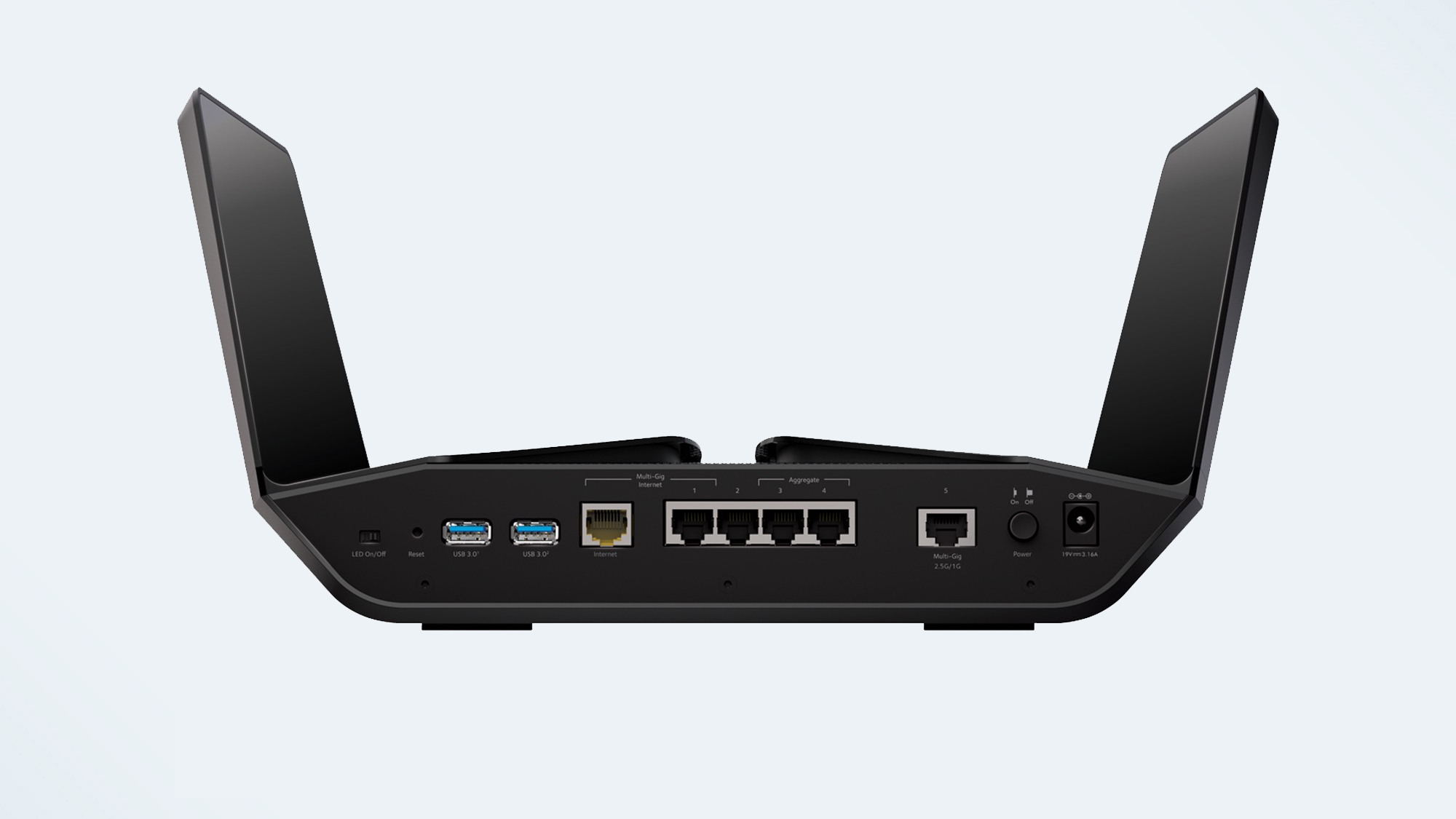
In addition to buttons for using the router’s Wi-Fi Protected Setup (WPS) and turning off the system’s Wi-Fi transmissions, rendering the RAXE500 as the equivalent of a wired router, there’s a pair of USB connections for mounting hard drives on the network. There’s a power connection as well as an on/off button and a recessed reset button that reverts the RAXE500’s settings to the way it left the factory.
Happily, the RAXE500 has a switch for turning off the dozen LEDs that light up when the router is operating, although this can also be done in the router’s software. There are activity lights for power, Internet and its three data bands as well as its wired Ethernet ports and the two USB connections.
Netgear Nighthawk RAXE500 review: Performance and in use
With its ability to move data back and forth in the 2.4-, 5- and 6GHz bands, the Nighthawk RAXE500 blew other routers away. Using Ixia’s ixChariot’s network simulation software and a Samsung Galaxy S21 Ultra – one of the rare devices that can take advantage of Wi-Fi 6e’s potential – I created a busy network with 10 simulated users. After setting the router up 15-feet from the S21 phone and using the RAXE500’s SmartConnect, channel 36 (for 5GHz) and channel 33 (for 6GHz), the RAXE500 delivered a peak throughput of 1.153Gbps for the 6Ghz band and another 1.242Gbps for the 2.4- and 5GHz bands. That’s a total of 2.396Gbps at 15 feet.
That’s a 42 percent jump over the Netgear Nighthawk AX8’s already-impressive 1.389Gbps. Other Wi-Fi 6 routers were similarly left in the digital dust, with the Asus AC-RT86U’s managed 929.7Mbps, the TP-Link Archer AX6000 moving 884.4Mbps and the Linksys MR9600 delivering 822.0Mbps. That’s a nearly three-fold improvement with the router and client close to each other.

On the downside, as was the case with the AX8, the RAXE500’s throughput falls off quickly with distance, making it the router to use close up. With 50 feet between the RAXE500 and the Galaxy S21 phone, the total throughput dropped to 215.8Mbps, well off the pace set by the TP-Link Archer AX6000 (396.4Mbps) or the Linksys MR9600 (363.3Mbps). At this distance, the Netgear Nighthawk AX8 was mid-pack at 277.1Mbps.
At 75-feet, the RAXE500 moved 148.6Mbps versus the AX8’s 142.3Mbps. The winner at this distance was the Asus AC-RT86U’s 250.1Mbps with 40 percent more delivered bandwidth. Our testing uses a terminal distance of 90-feet, and the RAXE500 managed to move 18.9Mbps, enough for some HD video and some web browsing. The Netgear AX8’s bandwidth was a similar 20.8Mbps while the TP-Link Archer AX6000 and Linksys MR9600 were offline at this distance. The RAXE500 had a range of 105-feet.
The RAXE500 was one of the best at distributing Wi-Fi throughout an older house with thick walls and floors. In my 100 year old home with the Galaxy S21 phone 20 feet and a wall away from the router, it still managed to grab 1.137Gbps of bandwidth from the RAXE500. That’s the best we’ve seen and about 5 percent more data flow than the 1.078Gbps the AX8 was capable of. By contrast, the TP-Link Archer AX6000 and Asus RT86U moved about 40 percent less data at 738.0Mbps and 698.5Mbps.
It was just as good at sending a strong signal through a ceiling to a bedroom a floor above the router’s location. It delivered 851.0Mbps, while the TP-Link Archer AX6000 able to move 671.4Mbps and the Netgear AX8 pushed 629.5Mbps.
A reliable router over a week of daily use moving files, online gaming, shuffling through email and watching 4K videos, it passed our saturation test. While a Macbook Air played YouTube videos and a Galaxy S21 phone played online music, a Dell XPS 15 streamed an Internet radio feed and an HP Elitebook moved files onto and off a networked RAID server. None of the audio or video balked or had artifacts.
As it was moving bytes back and forth, the RAXE500 used a peak of 15.4 watts, which drops to 5.4 watts when the router is idle but still turned on. It took about 10 seconds to wake it up with a data request from a connected client. If the router is used for eight hours and day and it’s idle the rest, the system should cost about $13.70 a year, assuming you pay the national average of 13 cents per kilowatt hour of electricity. That’s a third more than the Netgear Nighthawk AX8’s $10.50 and twice the $6.80 that the Linksys MR9600 costs to use.
Netgear Nighthawk RAXE500 review: Setup
Like many competitors, the Nighthawk RAXE500 provides the choice of using a connected browser to set it up or logging onto Netgear’s Nighthawk app. There are versions for Android and iOS. Both approaches provide illustrations and instructions for setting it up. Using the app and a Samsung Galaxy S21 Ultra phone, the first step is to get the Nighthawk app, install it and accept its license.
I had to allow the app to see my phone’s location to get things going. Then, I created a Netgear account, which required an email verification.
After I plugged the router in and restarted my broadband modem, I followed the illustrated instructions by picking the type of networking gear I had. Then, I snapped a picture of the router’s QR code.
After the router restarted and displayed a slide show of the Armor security software’s attributes, I confirmed that the router was connected to the Internet. Next, I changed the system’s names and passwords for the combined 2.4- and 5GHz LAN and one for the 6GHz transmissions. I finished off by answering two verification questions.
As it finished up, the router gave me the option of printing all the settings, just in case. Finally, the RAXE500 asked if I wanted to use two factor authentication for making changes to the router’s settings. It connected on the first try with an iPad. The set up process took all of 16 minutes to turn the RAXE500 into an operating tri-band network.
Netgear Nighthawk RAXE500 review: Configuration
The RAXE500 has a multitude of options for customizing the router. This can be done via the app but there are many more options available by using the connected browser approach. All it takes is typing “netgearlogin.com” into the browser’s address and entering the router’s administrative password, and a wide variety of configuration choices are available.
The router’s Home page shows lots of operating data, including the current firmware version along the top. In addition to Internet status, the Wi-Fi name and password, it shows how many devices are connected. There’s information on the status of the Armor security software and the Guest Network as well as if any drives are connected. Click on any for details, like whether Multi-Gig inputs are enabled for the Internet section.
At any time, the interface let me run the setup procedure over or set up port forwarding. The RAXE500 allows subtle changes, like altering the RTS Threshold, changing the Fragmentation Length or picking between the long or short Preamble.
At any time, it’s easy to run a speed test of the Internet connection as well as check on the connection’s details. In addition to running as a router, the RAXE500 can be set up as a wired access point. Unlike gear from Asus and Linksys, it can’t be converted to a mesh routing system.
As is the case with many of Netgear’s products, the RAXE500 comes with the company’s Armor security software but does without the Disney Circle or any parental controls. The company plans to add its own parental control app in the near future. Based on Bitdefender’s Total Security software, Armor has apps for all popular programs, from Windows and Mac to Android and iOS; the lineup lacks a Linux option, though. It does a good job of defending the network and its devices but only includes updates for a month. After that it costs $70 per year. By contrast, Asus includes lifetime updates for its AIProtection Pro defenses.
Like other Netgear products, the company includes a year of warranty protection but only 90 days of service and support. That’s a pittance compared to the two years that Asus provides for its high-performance routers. Upgrading to a two year warranty with support costs $120.
Happily, the Netgear free online support is open to all and contains lots of self-serve help. In addition to troubleshooting assistance and help setting the router up, the site has firmware, an installation guide and videos on tap.
Netgear Nighthawk RAXE500: Verdict
Welcome to the Wi-Fi 6e era. The Netgear Nighthawk RAXE500 is the first of an expected onslaught of tri-band Wi-fi 6e routers that push Wi-Fi performance to the limit. It’s been worth the wait because the RAXE500 blows the competition out of the water with the ability to move nearly 2.5Gbps at close range. It not only speeds past Wi-Fi 6 routers but is the fastest router on the planet and sets a new standard for high-performance Wi-Fi. More to the point, it is the ideal router for the real world because in addition to security software, the RAXE500 punches a strong signal through walls and floors to help fill an older house with lots of nooks and crannies.
Rather than being stuck with using either a connected browser or an app, Netgear lets you choose which way you want to install and configure the RAXE500. It offers one of the most complete assortments of customization options – From RTS Threshold to which Wi-Fi channels it uses – so that the RAXE500 can be set up the way you want it to.
It costs twice as much as lower-performing routers, like the TP-Link Archer AX6000 or the Linskys Max Stream MR9600, but the Netgear Nighthawk RAXE500 is worth it because it delivers more data. In other words, the RAXE500 not only brings Wi-Fi up to date but raises the performance bar for others to try to meet. Sure, it’s expensive, but if you want to be the first on your block to tap into the performance potential of Wi-Fi 6e, this is your kind of router.
Brian Nadel is a freelance writer and editor who specializes in technology reporting and reviewing. He works out of the suburban New York City area and has covered topics from nuclear power plants and Wi-Fi routers to cars and tablets. The former editor-in-chief of Mobile Computing and Communications, Nadel is the recipient of the TransPacific Writing Award.
